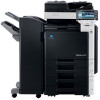Konica Minolta bizhub C280 Product Guide - Page 55
Ipv6 Support, Ipsec Protocol Support, Encrypted Network Password Printing, Mfp Administrator Settings
 |
View all Konica Minolta bizhub C280 manuals
Add to My Manuals
Save this manual to your list of manuals |
Page 55 highlights
bizhub C360/C280/C220 Print Features & Functions IPv6 SUPPORT IPv6 is the acronym for Internet Protocol version 6. It is a network IP standard used by electronic devices to exchange data across the network. It follows IPv4 as the second version of the Internet Protocol. The main feature of IPv6 that has everyone excited is the use of larger address space. IPv6 supports addresses that are 128 bits long versus 32 bits in IPv4. While the IPv4 address space contains 4,294,967,296 addresses, IPv6 has enough room for 340,282,366,920,938,463,463,374,607,431,768,211,456 (340 undecillion, 282 decillion, 366 nonillion, 920 octillion, 938 septillion, 463 sextillion, 463 quintillion, 374 quadrillion, 607 trillion, 431 billion, 768 million, 211 thousand, 456) unique addresses. Currently an IP address (IPv4) contains 4 "positions" (212.15.10.4) for each IP address. IPv6 allows for 6 "positions". IPSEC PROTOCOL SUPPORT Standard with IPv6, this suite of protocols offers secure Internet Protocol (IP) communications by authenticating and/or encrypting each IP packet in a data stream. ENCRYPTED NETWORK PASSWORD PRINTING This function enables the System Administrator to define the passphrase that will be used to encrypt authentication credentials (User Authentication, Account Track, Secure Print). To enable this feature, the System Administrator must set it on the MFP (Administrator Settings , Security Settings , Driver Password Encryption Setting) first. Once enabled on the MFP, the same "defined" passphrase is entered on the PCL and/or PS Print Driver(s). The passphrase entered on the MFP must match what is entered on the drivers. If this function is not activated, the authentication credentials (User Authentication, Account Track, Secure Print) are still encrypted. They will use the factory default for encryption instead of a user (System Administrator) defined passphrase. 51















